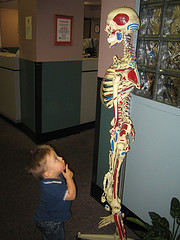Tell The Feds What You Think About A Centralized System For Reporting Medical Errors
Image courtesy of (Pfau)
(Pfau)
Thus, the federal Agency for Healthcare Research and Quality is currently working on a prototype system that would create a centralized portal for consumers — and they are asking for the public’s input.
“There is a growing body of evidence that many adverse medical events go unreported in current systems,” writes the AHRQ, adding that the primary reason is because most of the current reporting systems either do not elicit or do not accept reports from patients and/or their families, choosing instead to rely solely on hospitals and other care providers to report patient safety incidents.
“Patient reports could complement and enhance reports from providers and thus produce a more complete and accurate understanding of the prevalence and characteristics of medical adverse events,” explains the agency.
And though many states require hospitals to report every incidence in which a patient suffers harm, a recent report from the Dept. of Health and Human Services inspector general’s office found that of the harmful events it could identify, only 12% meet current state requirements for being reported — and hospitals are only reporting about 1% of harmful events.
ProPublica’s Marshall Allen writes about the woeful state of patient harm reporting he found in Las Vegas:
We used hospital billing records to identify 3,689 cases of patient harm at the city’s hospitals in a two-year period. Each of those cases would fit the state’s definition of a “sentinel event,” meaning the hospitals were required by law to report them. Yet in the same time period they reported to the state only 402 sentinel events.
So now AHRQ is seeking public comment on its plans for a central reporting system, which, from what we could tell, would act not terribly unlike the complaint portals recently launched by the Consumer Financial Protection Bureau for credit cards, banks and loans.
There are currently two aspects to the system:
1. Safety event intake form and follow up. This is where patients and/or families fill in a standard form regarding “medical error or mistake, harm or injury as well as near misses.”
The inclusion of near misses is very important, as these are almost always left off of reports made by hospitals to their state regulators.
Consumers filling in the form (or calling in) will be asked “what happened, details of the event, when, where, whether there was harm, the type of harm, contributing factors, disclosure, and whether the patient reported the event and to whom.”
They will also be asked if a staff member can contact them to clarify information if needed.
2. Health care provider follow up. For the consumers who consent, the agency will contact the health care provider to see share the consumer report with the provider’s patient safety officer, who “will determine if the consumer-reported incident matches an event in the provider’s Incident Reporting System, and if so, provide additional information.”
Explains the AHRQ:
Data collected will be analyzed to produce estimates and basic descriptive statistics on the quantity and type of consumer-reported patient safety events, examine the variability of responses to questions, examine the mode of data collection by event types, and conduct correlations, cross tabulations of responses and other statistical analysis.
The public comment period on this matter is open until Nov. 9, 2012. You can send your comments to AHRQ reports clearance officer Doris Lefkowitz at doris.lefkowitz@AHRQ.hhs.gov
More information on the proposal is available in the Federal Register.
Want more consumer news? Visit our parent organization, Consumer Reports, for the latest on scams, recalls, and other consumer issues.

